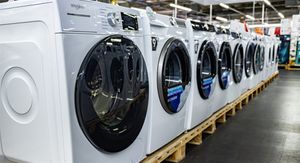
Last fall, Catalent, Inc. (NYSE: CTLT) climbed to a record high above $140 on rising demand for biologics and drug delivery technologies. Since then, fall is all it has done.
The latest plunge on November 1st was a high volume gapper that followed the company’s fiscal first quarter earnings dud. This put the stock decidedly into oversold territory by multiple technical analysis measures — and prompted bargain hunters to quickly swoop in.
Yet with the macro backdrop weakening for Catalent’s pharmaceutical and biotech customers, fundamental concerns could outweigh what the charts suggest.
What Drove Catalent’s Weak Fiscal Q1 Performance?
After delivering 23% top-line growth in fiscal 2022, Catalent’s end-market demand appears to be deteriorating. First quarter revenue came in slightly above $1 billion which was on par with the prior year period; organic revenue slipped 1%.
The bottom line result was more painful. Earnings per share (EPS) declined 52% and missed the consensus estimate by a country mile.
To be fair, Catalent has faced difficult if not impossible year-over-year comparisons to when Covid-related sales drove the stock to record heights. With pandemic conditions improving, the company has been under pressure to replace Covid revenue. The market has responded with impatience. Even 20% growth in new cell and gene therapy revenue streams in Q1 wasn’t enough to appease sellers. They chose to focus on the 2% decrease in overall Biologics sales.
Nor was it enough to see 11% organic revenue growth on the Pharma & Consumer Health side of the business. Instead, a bevy of costs and inefficiencies weighed heavily on market sentiment.
After building out its production capacity during the pandemic and then doubling down with new investments, Catalent has had a lot of elbow room at its facilities. Underutilization and onboarding expenses at newly acquired facilities contributed to a sharp Q1 margin contraction.
Eventually the acquisition spree could bear fruit, especially as contract manufacturing demand picks up — but for now, Catalent has a bit of an overhead problem.
What Challenges and Opportunities Lie Ahead?
Not surprisingly, the disappointing start to the year led management to backpedal on its outlook. It now expects full year revenue of $4.75 billion at the midpoint compared to the $5.10 billion estimate offered a few months ago. Projections for adjusted EBITDA and net income were also slashed.
Making such dramatic downward revisions so soon into the new fiscal year is a bad omen — and should cause investors to question leadership’s forecasting ability. There were likely signs that demand was fading well before the Q1 release. A pre-announcement, while painful, would’ve at least helped Catalent’s credibility.
Going forward, a heavy dose of economic uncertainty is the biggest risk to Catalent’s stock. This is especially a concern in Europe where the company derives a significant chunk of revenue. And if the U.S. economy enters a recession, drug development activity will undoubtedly slow. The pharmaceutical industry will spend less freely and investors will be more cautious. Yes, health care is a defensive sector, but this part of the sector tends to act more cyclical.
For Catalent’s end-market demand to improve, consumer demand for things like gummy vitamins and nutritional supplements will ultimately have to improve. In addition to drug development, Catalent’s core competencies include oral mechanisms for a range of consumer health products. Many vitamins and consumer health goods are considered essential, but spending on such items can become less than crucial when inflation wreaks havoc on households' budgets.
Is Catalent Stock Undervalued?
At first glance, Catalent shares look inexpensive at 15x fiscal 2023 earnings. Don’t be fooled. The P/E is where it is for good reason. Wall Street anticipates that EPS will be down 15% this year and then rebound to last year’s level by fiscal 2024. It would be a nice recovery but would only amount to hitting the reset button.
Plus, the balance sheet contains a significant amount of debt that was incurred to expand capacity. A total debt-to-equity ratio that has swelled to 88% is a sign of compromised financial stability.
Making matters worse, management has unveiled a plan to spread its capital spending budget over a longer period to generate cash flow. While the strategy makes sense, it suggests solvency is becoming a concern. Slowing sales growth and a tepid outlook will do that.
It’s not all doom and gloom for Catalent. The company still has valuable partnerships with leading drug makers and consumer health companies that make it a go-to supplier of biologics, oral delivery materials and manufacturing services.
Unfortunately, the economic landscape has many of its customers putting growth plans on hold. Until end market demand re-accelerates, prospective Catalent investors should do the same.




